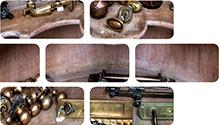
Architectural Salvage Miscellaneous 17 09 04
Architectural salvage is a wide range of items and materials that have an architectural value, which includes building materials, windows, doors, door furniture, panelling, flooring, period fireplaces, and bathroom and kitchen items. They are made in various colours, styles, shapes and sizes, depending on the specification required. They are of varying age, quality, finish and value depending on their function, architectural finish and condition. Beware of large, top-heavy items when dismantling, moving and in storage.
Working With
Usage & Probable Locations
Architectural salvage has a use in all manner of architectural design, form and function of aged buildings, structures and infrastructure. They are from previous ages that are available following demolition and refurbishment for conservation or period uses. They are commonly located in period houses, farmsteads, castles, mills, hospitals, schools, stately homes and buildings used for civic functions.
Personal Protective Equipment
PPE requirements indicated are for guidance purposes only. DRIDS has identified the PPE that is mandatory on all demolition projects and ones that may be required subject to site specific Risk Assessment & Method Statement (RAMS). Hover over the icon to determine the types of PPE required for the removal of this material.
Removal, Segregation & Storage
Architectural salvage destined for reuse should be removed, cleaned of mortar and fixings, segregated and stored carefully and safely, to ensure their integrity and good condition. They should be stacked on timber pallets and bound with soft materials and cling film to prevent chips, cracks and breakage. Preferably they should be stored inside a building or under cover before removal from site, even though they are mostly robust against inclement weather. Architectural salvage destined for recycling or recovery should have contaminants, fixtures and fittings removed before distribution for further processing. Any crushed inert materials should be screened and stored in piles. Architectural salvage, rarely destined for landfill should be placed in mixed waste skips.
Tools
Fixtures, Fittings & Connections
Architectural salvage is commonly fixed in place on brackets, with screws, wooden plugs, nuts and bolts, metal straps, mortar, screed or other binding agent. Some items require no fixings, they stand in place on feet or other platform. They may be connected to water, drainage and electrical systems, so care should be taken to shut off or block these outlets before removing items. Taps, handles, brackets, hinges, locks, straps, pipe work, drains and associated mounts may also be of value or will need separating from the units before recycling or disposal. Sometimes the simplest of items may be of significant value.
Health & Safety
Subject to task-specific Risk Assessment & Method Statement (RAMS). Wear gloves and face mask when handling architectural salvage, crushed materials or ironmongery to prevent irritation, cuts and abrasion. Use eye protection when using hand tools. Limit hand, arm and whole body vibration when using impact tools. Only use 360 plant and attachments or screeners if appropriately trained. Wash hands before eating or drinking.











